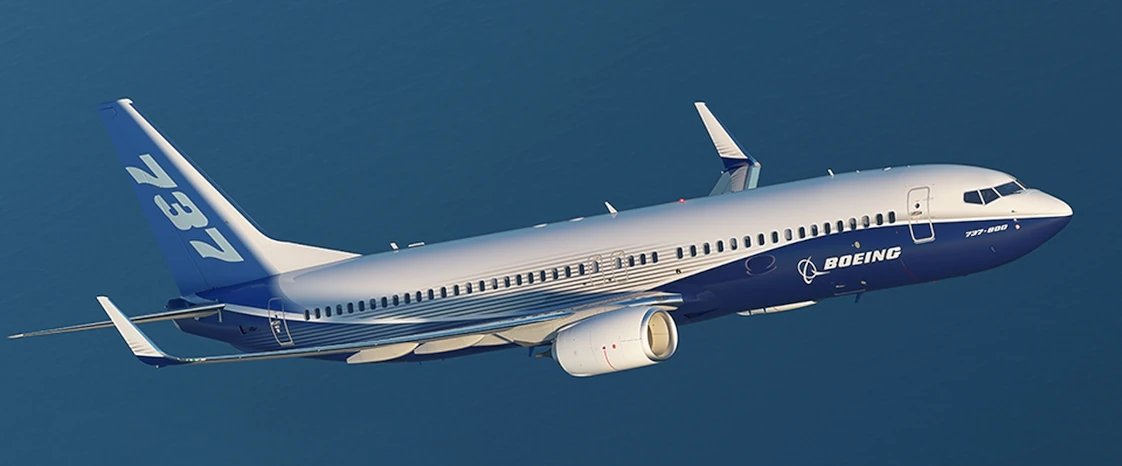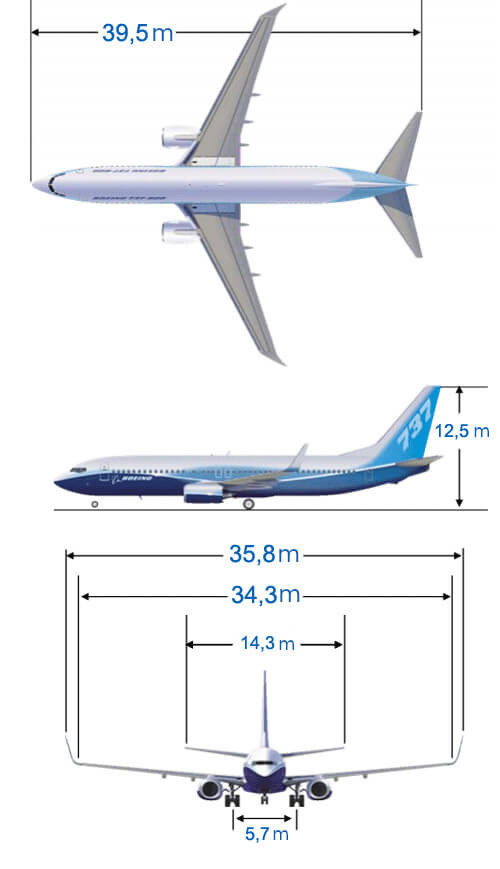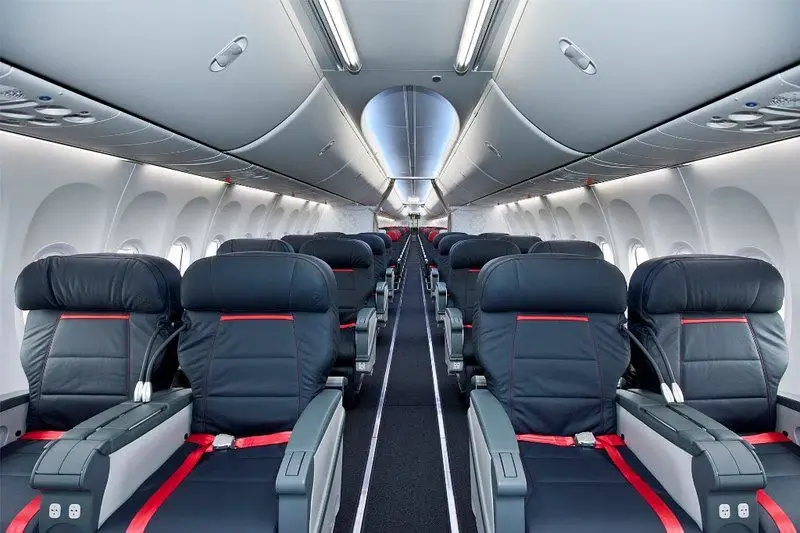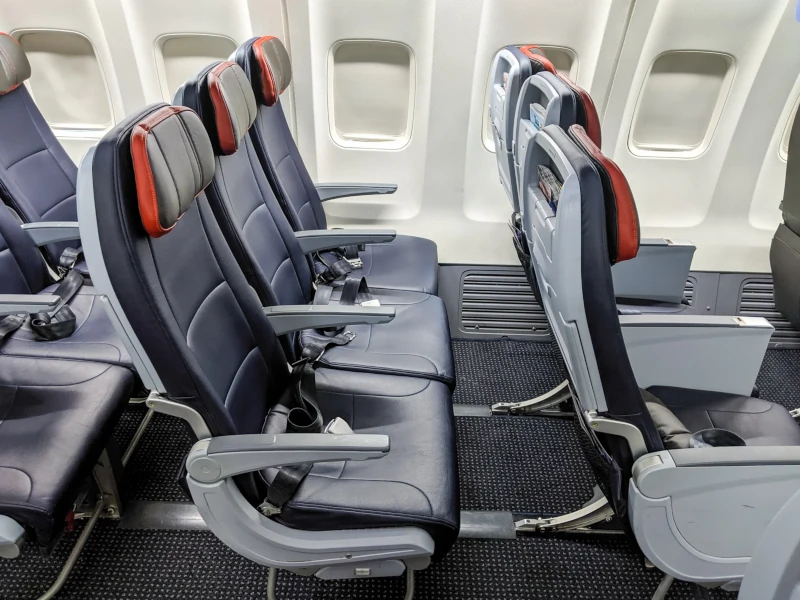
Boeing 737 800 Overview
The Boeing 737-800, sometimes referred to as the 738-Boeing 737, airplane belongs to the Boeing 737 Next Generation family of airliners developed in the 1990s. Therefore, it can be abbreviated as Boeing 737-800 NG.
The Boeing 737 800 twin-engine passenger airplane is a family of narrow-body airplanes designed for short- and medium-range routes. First of all, Boeing 737-800 was designed to replace the Boeing 737-400 passenger airliner of the «Classic» series. Today, the direct competitor for the Boeing 737-800 is the Airbus A320 narrow-body passenger airplane.
The maximum capacity of the Boeing 737-800 is 189 passengers. More seats cannot be placed in the airplane, as evacuation time standards will not be met. To meet them, emergency exits had to be added to the fuselage.
Development History of the Boeing 737 800
Boeing launched the Boeing 737-800 program in 1994 after receiving an order for more than 40 aircraft. The Boeing 737-800 made its first flight on July 31, 1997.
Certification of the airliner was completed on March 13, 1998, and the first delivery was made to German airline Hapag-Lloyd on April 22, 1998. Two days later, on April 24, the aircraft made its first commercial flight.
Work on the Boeing 737 800 aircraft commenced on September 5, 1994, initially under the project name 737-400X Stretch, indicating its predecessor status. The project was later renamed to 737-800.
Compared to its predecessor, the Boeing 737-400, the fuselage of the new aircraft increased in length by 3.02 meters, resulting in an expanded passenger capacity. In a two-class cabin configuration, it accommodates 162 passenger seats, including 12 business class seats and 150 economy class seats. In a single-class configuration, the passenger capacity reaches 189 seats.
Powered by CFM International CFM56-7B24s turbofan engines with a thrust of 107.6 kN, some Boeing 737-800s with increased payload capacity were equipped with CFM56-7B27s engines, boasting a thrust of 121.4 kN.
The aircraft is equipped with digital avionics EFIS from the American company «Honeywell,» displaying information on six multifunctional LCD screens. It also features an Instrument Landing System (ILS) or Head-Up Display (HUD).
The maiden flight of the Boeing 737 800 took place on July 31, 1997, with the first deliveries to airlines occurring in April 1998. «Hapag-Lloyd Flug» became the first customer, while «Ryanair,» an Irish airline and one of the largest budget carriers in Europe, placed the largest order for 299 units of the 738 Boeing 737. Currently, these aircraft operate in a single-class, economical cabin layout, providing 189 passenger seats.
Boeing 737 800 Technical Details
Passenger Cabin
| Crew | 2 pilots |
| Passenger Capacity | 189 |
Dimensions
| Length (M) | 39.50 |
| Height (M) | 12.60 |
| Wingspan (M) | 34.32 |
| Wing Area (sq. m) | 124.58 |
| Fuselage Width (m) | 3.76 |
| Cabin Width (m) | 3.53 |
Weight
| Empty Weight (kg) | 41480 |
| Max Takeoff Weight (kg) | 79016 |
| Max Landing Weight (kg) | 66361 |
Flight Data
| Range (km) | 7408 |
| Cruising Speed (KM/H) | 936 |
| Max Speed (KM/H) | 978 |
| Takeoff Distance (M) | 2241 |
| Landing Distance (M) | 1634 |
| Engines | 2 × CFM International CFM56-7B24 |
| Engine Thrust (kN) | 2 × 107 |
| Max Fuel Capacity (L) | 26035 |
| Max Altitude (M) | 12500 |

738 Boeing 737 Modifications
Boeing 737-800BCF is the cargo version of the aircraft, equipped with a side cargo door, allowing it to transport up to 26,300 kg of cargo over a range of 3,218 km.
Boeing 737 P-8 Poseidon is a versatile aircraft designed for naval aviation, based on the 737-800ERX. It aims to replace the aging P-3 Orion, a legendary anti-submarine aircraft from the Cold War era. The P-8 Poseidon is designed for detecting and eliminating enemy submarines in patrol areas, participating in reconnaissance, anti-ship, and rescue operations in coastal and open ocean regions. It is based on the structure of the updated Boeing 737-800, featuring wings without winglets but with enhanced wing sweep.
Boeing 737 800 Seat Map
The Boeing 737-800 cabin follows a standard layout designed to accommodate six seats per row in a 3+3 formula, separated by an aisle.
Some airlines incorporate a full-fledged business class in the cabin, featuring wider seats arranged in a 2+2 configuration on the Boeing 737-800 seat map, resulting in a reduced overall cabin capacity.
Above the Boeing 737-800 seating, there are overhead compartments for carry-on luggage. Two lavatories are located in the tail of the aircraft, and one is situated in the front near the cockpit.
The Boeing 737-800 first class does not feature a configuration. This model is typically used for medium and short-haul flights and is equipped with a two-class configuration, including business class and economy class. The passenger cabin can vary in seating capacity based on specific airline requirements, but the absence of a Boeing 737 800 first class is a standard feature for the plane.
The seating arrangement can be observed on the Boeing 737-800 Seat Map below:

Boeing 737-800 Business Class
Business Class 20 seats are arranged in a classic pattern — 5 or 3 rows with 2 seats on each side of the aisle.
As expected, the passenger seats are wide and comfortable, with a considerable distance between seats and maximum recline. Each of the Boeing 737-800 seats is equipped with a screen featuring constantly updated audio and video content.Passengers have the option to listen to music, audiobooks, watch movies, cartoons, and even entertainment shows.
The aircraft configuration Boeing 737-800 Business Class includes USB ports for smartphone charging and standard outlets for charging laptops and other devices. For maximum comfort, passengers are provided with blankets, pillows, and quilts.

Some airlines, especially those that use Boeing 738 for shorter and regional routes, may offer business class, which can sometimes include some elements resembling first class, such as upgraded seats and service.

Economy Class
The Economy Class includes seats from row 6 to row 28 of the aircraft. These Boeing 737-800 seating are usually more economical compared to the previous class, but they come with their own advantages.
The services provided in these rows typically depend on the airline. In the Boeing 737, each seat is equipped with a foldable tray table and an in-flight magazine. For longer flights, passengers are offered sleeping amenities, personal hygiene products, and meals. The food selection here is usually more modest compared to the Business Class. Hot and cold beverages are also offered to passengers during the flight.
Comparison of Boeing 737 800 Seat Maps
| Airline | Classes / Configuration | Total Seats |
|---|---|---|
| American Airlines Boeing 737-800 | First / 3-3 Economy / 3-3 |
160, 172 |
| Air Transat Boeing 737-800 | Economy / 3-3 | 189 |
| Aeroflot Boeing 737-800 | Business / 2-2 Economy / 3-3 |
158 |
| Air China Boeing 737-800 | First / 2-2 Economy / 3-3 |
159, 167 |
| Delta Air Lines Boeing 737-800 | First / 3-3 Economy / 3-3 |
160 |
| Corendon Airlines Boeing 737-800 | Economy / 3-3 | 312 |
| Vistara Boeing 737-800 | Business / 2-2 Economy / 3-3 |
168 |
| Boeing 737 800 Ryanair | Economy / 3-3 | 189 |
| United Boeing 737-800 | Economy / 3-3 | 166 |
| Boeing 737 800 SunExpress | Economy / 3-3 | 189 |
| Boeing 737-800 Turkish Airlines | Business / 3-3 Economy / 3-3 |
155 |
| Southwest Airlines Boeing 737-800 | Economy / 3-3 | 175 |
| WestJet Boeing 737-800 | Economy Premium / 2-2 Economy / 3-3 |
174 |
| Virgin Australia Boeing 737-800 | Business / 2-2 Economy / 3-3 |
176 |
| Ukraine Airlines Boeing 737-800 | Business / 2-2 Economy / 3-3 |
180 |
| TUI Airways Boeing 737-800 | Economy / 3-3 | 189 |
| Korean Air Boeing 737-800 | Business / 2-2 Economy / 3-3 |
147 |
| Kenya Airways Boeing 737-800 | Business / 2-2 Economy / 3-3 |
145 |
| KLM Boeing 737-800 | Business / 2-2 Economy / 3-3 |
176 |
| Japan Airlines (JAL) Boeing 737-800 | Business / 2-3 Economy / 3-3 |
165 |
| Jet2.com Boeing 737-800 | Economy / 3-3 | 189 |
| Hainan Airlines Boeing 737-800 | Business / 2-2 Economy / 3-3 |
164 |
| Garuda Indonesia Boeing 737-800 | Business / 2-2 Economy / 3-3 |
162, 170 |
| Fiji Airways Boeing 737-800 | Business / 2-2 Economy / 3-3 |
170, 164 |
| Eurowings Boeing 737-800 | Business / 2-2 Economy / 3-3 |
174 |
| Ethiopian Airlines Boeing 737-800 | Business / 2-2 Economy / 3-3 |
154 |
| China Eastern Airlines Boeing 737-800 | Business / 2-2 Economy / 3-3 |
162, 164, 170 |
| S7 Airlines Boeing 737-800 | Business / 2-2 Economy / 3-3 |
176 |
| SilkAir Boeing 737-800 | Business / 2-2 Economy / 3-3 |
162 |
| Scandinavian Airlines (SAS) Boeing 737-800 | Economy / 3-3 | 181 |
| Royal Air Maroc Boeing 737-800 | Business / 2-2 Economy / 3-3 |
159 |
| Qantas Boeing 737-800 | Business / 2-2 Economy / 3-3 |
174 |
| Norwegian Boeing 737-800 | Economy / 3-3 | 186 |
| Malaysia Airlines Boeing 737-800 | Business / 2-2 Economy / 3-3 |
160 |
| Polish Airlines Boeing 737-800 | Business / 2-2 Economy / 3-3 |
174 |
| China Airlines Boeing 737-800 | Business / 2-2 Economy / 3-3 |
158, 161 |
| Copa Airlines Boeing 737-800 | Business / 2-2 Economy / 3-3 |
154, 160 |
| China Southern Airlines Boeing 737-800 | Business / 2-2 Economy / 3-3 |
159-178 |
| Alaska Airlines Boeing 737-800 | Business / 2-2 Economy / 3-3 |
159 |
| Oman Air Boeing 737-800 | Business / 2-2 Economy / 3-3 |
154, 156, 162 |

